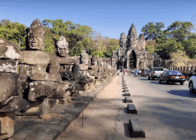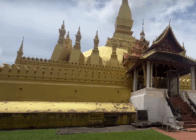Introduction to Tu Duc Tomb in Hue
Tu Duc Tomb stands as one of the most significant historical sites in Vietnam. Constructed between 1864 and 1867, this majestic tomb is dedicated to Emperor Tu Duc, the fourth ruler of the Nguyen Dynasty. Known for his literary prowess and deep philosophical thoughts, Tu Duc’s influence extended far beyond his reign. His final resting place reflects his personality, preferences, and the era’s architectural ingenuity.
The tomb’s architectural style is an amalgamation of traditional Vietnamese design and the emperor’s unique aesthetic sensibilities. The complex comprises various structures, including pavilions, temples, and lakes, each meticulously crafted to symbolize different aspects of the emperor’s life and reign. With intricate carvings, serene gardens, and reflective waters, Tu Duc Tomb is a masterpiece that continues to captivate visitors from around the world.
Exploring the Rich History of Tu Duc Tomb
Emperor Tu Duc’s Life and Legacy
Born in 1829, Emperor Tu Duc ascended the throne in 1847 and ruled Vietnam until his death in 1883. His reign was marked by internal strife and external challenges, particularly the increasing aggression from French colonial forces. Despite these tumultuous times, Tu Duc is remembered for his contributions to literature, culture, and the arts. He composed over 4,000 poems and numerous essays, reflecting his intellect and depth of thought.
Tu Duc’s construction of his tomb began long before his death, as was customary for many emperors of the time. The site was chosen for its natural beauty and strategic location, offering both seclusion and security. The emperor personally oversaw the project, ensuring that every detail aligned with his vision and values.
Architectural Significance
The layout of Tu Duc Tomb is a harmonious blend of nature and architecture. The main complex is divided into two primary sections—the temple area and the tomb area. The temple area includes the Hoa Khiem Temple, where Emperor Tu Duc and his empress were worshipped. This section also houses the Minh Khiem Theatre, one of the oldest surviving theaters in Vietnam, where the emperor enjoyed performances of traditional music and dance.
The tomb area, on the other hand, is where the emperor’s sarcophagus lies. Surrounded by pine forests and lotus ponds, the tomb exudes tranquility and reverence. The Buu Thanh stone wall encloses the burial site, symbolizing protection and eternal peace. Statues of mandarins, soldiers, and mythical creatures guard the tomb, each representing loyalty, strength, and vigilance.
Symbolism and Design
Every element of Tu Duc Tomb carries symbolic meaning. The lotus ponds, for instance, signify purity and enlightenment, while the pine trees represent longevity and resilience. The intricate carvings on the stone steles narrate the emperor’s achievements and philosophical reflections, serving as a historical record for future generations.
The combination of natural and man-made elements creates a balanced and serene environment. The layout encourages introspection and contemplation, allowing visitors to connect with the emperor’s legacy on a deeper level.
Journey Through the Grounds
A Virtual Tour of Tu Duc Tomb
Stepping into Tu Duc Tomb is like entering a different era. Begin your tour at the Khiem Cung Gate, the main entrance adorned with detailed carvings and calligraphy. As you walk through, you’ll be greeted by the Luu Khiem Lake, a picturesque body of water reflecting the surrounding foliage and structures. The lake is dotted with small islets, each featuring its pavilion, where the emperor often retreated for solitude and inspiration.
Continue to the Hoa Khiem Temple, a grand structure dedicated to the emperor and his empress. The temple’s interior is adorned with antique furniture, royal artifacts, and stunning paintings, offering a glimpse into the opulence of the imperial court. Nearby, the Minh Khiem Theatre stands as a cultural landmark, where traditional performances continue to entertain visitors.
Key Areas and Their Significance
The Stele Pavilion, located to the east of the temple area, houses a massive stone stele inscribed with Tu Duc’s autobiography and reflections. This stele is renowned for its candidness, as the emperor openly discusses his successes and failures, providing valuable insights into his character.
Move towards the tomb area, where the Buu Thanh stone wall encircles the emperor’s final resting place. The modest yet elegant structure is surrounded by lush greenery and peaceful lotus ponds, creating a serene atmosphere. Statues of mandarins, horses, and elephants line the path, symbolizing the emperor’s loyal subjects and guardians.
Tips for Visitors
To make the most of your visit to Tu Duc Tomb, consider timing your trip early in the morning or late in the afternoon when the weather is cooler, and the crowds are thinner. Wear comfortable walking shoes, as the complex is expansive and requires a fair amount of walking. Don’t forget to bring a camera to capture the stunning architecture and scenic views.
Engage with local guides who can provide in-depth historical context and interesting anecdotes about the site. Additionally, take time to explore the surrounding areas of Hue, including other imperial tombs and the famous Hue Citadel, to gain a comprehensive understanding of Vietnam’s royal heritage.
The Legacy of Tu Duc Tomb
Conservation Efforts and Challenges
Preserving Tu Duc Tomb is an ongoing effort that requires collaboration between local authorities, historians, and conservationists. The site faces several challenges, including environmental degradation, weathering of stone structures, and the impact of tourism. However, dedicated conservation programs aim to restore and protect this invaluable heritage site for future generations.
Efforts include regular maintenance of the structures, reforestation of the surrounding areas, and the implementation of sustainable tourism practices. Educational programs are also conducted to raise awareness about the importance of preserving cultural heritage.
Impact on Modern Culture and Tourism
Tu Duc Tomb continues to play a significant role in Vietnam’s cultural landscape. It attracts thousands of visitors each year, contributing to the local economy and promoting cultural exchange. The site also serves as an educational resource, offering insights into the country’s history, architecture, and artistic traditions.
The tomb’s influence extends beyond tourism. It inspires contemporary artists, writers, and filmmakers, who draw from its rich history and symbolism. Events and festivals held at the site celebrate traditional Vietnamese culture, fostering a sense of pride and continuity among the local community.
Conclusion
Tu Duc Tomb in Hue is more than just a historical monument; it is a living testament to Vietnam’s rich cultural heritage and the enduring legacy of Emperor Tu Duc. For history buffs, travel enthusiasts, and cultural explorers, visiting this site offers a unique opportunity to connect with the past and gain a deeper appreciation for the country’s history.
If you’re planning a trip to Vietnam, make sure to include Tu Duc Tomb in your itinerary. Share your experiences and insights with fellow travelers and history enthusiasts, and contribute to the ongoing conversation about preserving our shared cultural heritage.
Ready to explore the majesty of Tu Duc Tomb? Book your trip today and immerse yourself in the beauty and history of this incredible site.
- Uncover Cambodia’s Hidden Charms 6 Days / 5 Nights (123 views)
- The Best Exotic Vietnam – 16 Days / 15 Nights (111 views)
- Seamless Cruise: Halong Bay to Da Nang – Fostering smooth travel experience from Halong Bay to Da Nang. (51 views)
- Vietnam Culinary Tour: Your Definitive Guide to a Food Lover’s Journey (48 views)
- Top Vietnam Tour Operators – The Ultimate Guide to the Best Tour Companies for Vietnam (48 views)





























